
by Renee Owen | Nov 6, 2018 | Blogs, CEO's Kaleidoscope, Director's Blog, Home Page News
Kaleidoscope, October 2018
I wrote this Kaleidoscope before we had another national tragedy occur: The Tree of Life Synagogue massacre. It is with a broken heart that I add this “introduction” to Kaleidoscope.
Collaborative for Spirituality in Education
As I write, I am nestled safely indoors at the beautiful old Rockefeller home in New York, where 12 heads of schools are meeting to discuss how spiritually supportive schools can help to heal our world. This is the work of the Collaborative for Spirituality in Education (CSE) – an organization started by Dr. Lisa Miller of Columbia University Teachers College (Author of The Spiritual Child).
Through funding from the Rockefeller Brothers Fund and the Fetzer Foundation, the Rainbow Institute and several other schools are being paid generously to share our best practices in spiritual pedagogy. The CSE seeks to influence American education, at large, to honor the whole child and to create a more just and peaceful democracy.

Important Work
It’s an honor to be invited to do this important work, and I am developing relationships with these other heads of schools and faculty who are a part of the CSE. Some of these heads of schools are from Jewish Schools, who were here when the news of the tragedy hit, rather than home with their school community.
Together, we have been helping them bear the pain of this tragedy…and they have been helping us all remember the message of the Jewish people. “We are the people who were commanded by Moses to ‘Choose life’ and ever since, despite the tragedies of our history, past and present, have always striven to choose life and sanctify life.” (Rabbi Lord Jonathan Sacks).
Meeting hate with love
The continual message from these school leaders has been one of meeting hate with love. We chose life. We chose love. Though we are weary, we yet love. In the words of Dr. Martin Luther King:
“Darkness cannot drive out darkness; only light can do that. Hate cannot drive out hate; only love can do that.”
This is the message we will always share at Rainbow Community School with our children and with the world at large.

Harvest Season
It is harvest season, a time when the earth sheds its green and the light begins to shift, but the strength of life is ever apparent in nature’s cycles of renewal. This is the time of year for getting cozy and settling in. The children have become comfortable with the rituals and routines of the classroom. Their relationships with their teachers are becoming well-established.
[bctt tweet=”It is harvest season, a time when the earth sheds its green and the light begins to shift, but the strength of life is ever apparent in nature’s cycles of renewal. This is the time of year for getting cozy and settling in. ” username=”@rainbowcomsch”]
Thanks to the intentional work of all RCS faculty, students should feel comfortable to take risks in all domains, including testing their boundaries. Along with comfort comes developmentally appropriate challenges.
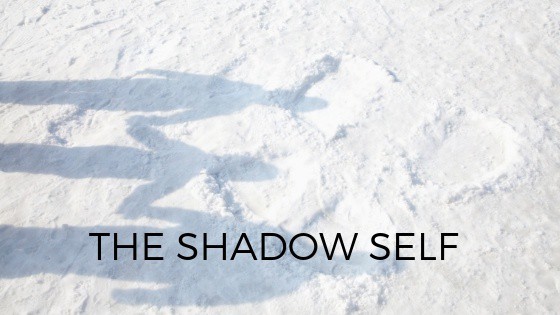
The shadow self
In many traditions, this is the time of year the “shadow” starts to reveal itself; and for Rainbow students, this is no different. The shadow is both a mystical concept and a psychological theory. Simply put, our shadow is the part of our being that we may consider inferior, or our “dark side” that we may repress or deny. However, the shadow need not be negative. Some consider the shadow to be the seat of human creativity.
How is your child exploring their shadow self? Perhaps they are toying with their mischievous side. Maybe they are discovering how they can avoid challenges, such as going to school or completing homework. They might be taking on new social personas, learning how they can “control” other children in positive or negative ways. Some children may be experiencing their first social rejection by a childhood friend.
All of these examples are normal, and even expected. The important thing is that we, as caring adults, provide a loving environment that doesn’t judge or shame them (or each other). We adults try to hold a balance between guiding them, while also allowing them to learn from the natural consequences of their mistakes.
Feel free to reach out to your child’s teacher or the counseling office for a check-in if your child’s behavior is particularly puzzling or if they are starting to have negative experiences at school. Will Ray, Director of Counseling, can be reached at extension 430. As director, Will works part time on campus; but someone in the counseling department is almost always on site. Katie Ford specializes in middle school. Elise Drexler is a play therapist. Kasie Caswell is an intern from Eastern Tennessee State University this year. Together, they make up a holistic team of caring providers.
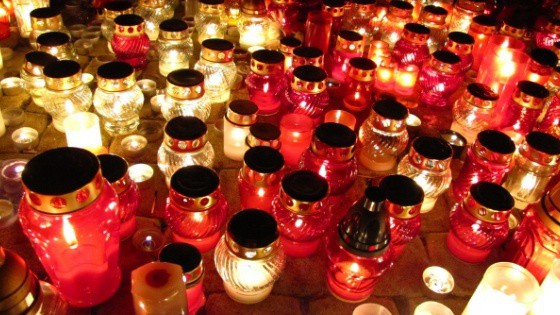
Día de los muertos
To honor and recognize the changing season–a time of unveiling our inner selves—we will hold a community fire on Friday, November 2 from 9am until the end of the day in the outdoor classroom. Some classes may incorporate the fire with their Día de los Muertos celebration. The space is open to all families, students, and staff. Please come and allow yourself to just be. Click here for the poem teacher Jason Cannoncro attached with the invite to the fire.
Making Learning Visible
You may have noticed a new section in Rainbow Reminders. Each week, at the end of the email, there is a new section called “Making Learning Visible” that describes various aspects of our curriculum and academic program. Making Learning Visible provides a peek into a different classroom each week, with a description of how various classroom activities help students learn and succeed.
Testing 1,2,3
Another marker of fall at Rainbow is standardized testing. We have nearly completed all testing, except for make-up sessions. In case you missed Making Learning Visible in the last Rainbow Reminders, click here to read about why we test and how we use test scores to help inform instruction. Last year’s scores are linked in the article with an easy-to-read graph.
What the heck goes on in Omega?!
Our middle school program is unique, and changes greatly from the elementary program. Middle school children become developmentally ready for demanding cognitive and executive function challenges. Our middle school students are given a lot of responsibility. “Know Thyself” is the theme of the Omega Middle School. Students are on a personal journey to discover their purpose and potential. They learn through community and through communing with nature.
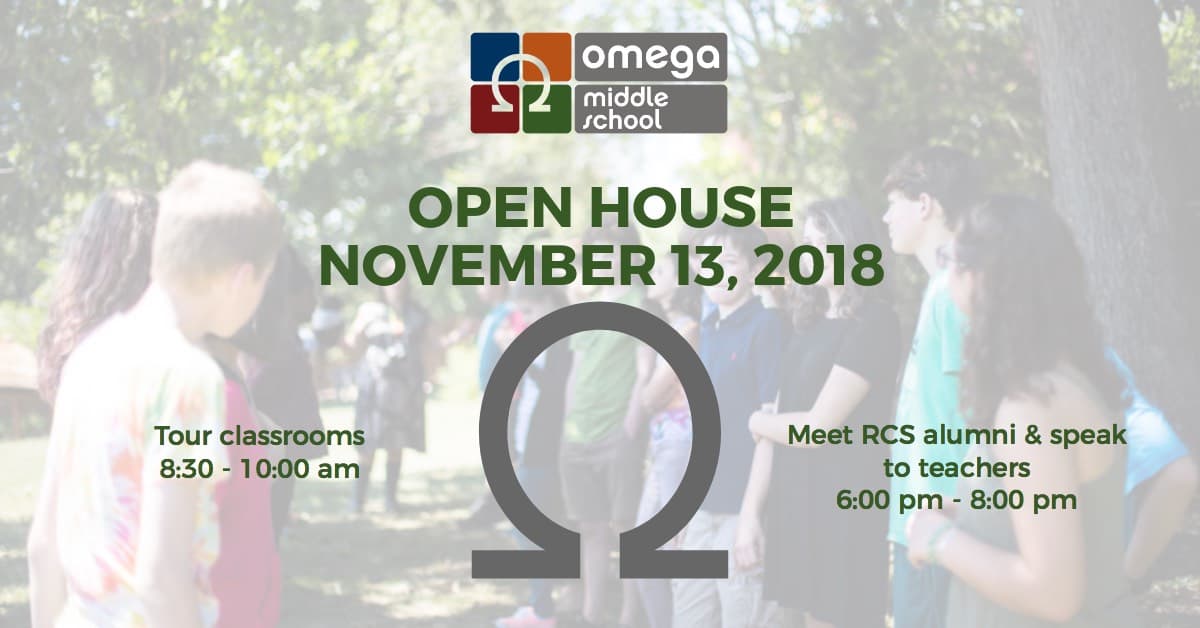
The Omega Open House
The very BEST way to learn about Omega? Attend the Omega Open House and the alumni panel. You can ask alumni any question you want. It’s never too early to start doing your homework. Even if your child is in kindergarten, it will help you understand what is ahead. The panel discussion is November 13, from 7-8pm.
It’s Campaign Time
I felt so good after making my pledge to the annual campaign! I love Rainbow. I love what a Rainbow education did for my kids. They are innovators in a changing world, and thriving. I know my contribution helps our vibrant programs.
I hope you will join me in pledging as soon as possible. The earlier you pledge, the less time we spend fundraising. That gives us more time to focus on what we do best – educating children! Click here to make your pledge. It’s easy to donate now, or you can pledge and RCS can bill you later.
Your financial support also provides moral support! Every time a pledge arrives for the annual campaign, a cheer goes up! Donations are a vote of confidence for our hard-working staff and volunteers.

Voluntary Equitable Tuition
Some people have asked about the difference between the Voluntary Equitable Tuition (VET) program and the Annual Campaign. The V in VET stands for “voluntary” — it is designed for people to voluntarily pay a higher tuition. The E stands for Equitable — parents who feel they can afford to pay a higher tuition do so out of the generosity of their hearts in an effort to make tuition more equitably distributed in our community (meaning those who can pay more do to help those who cannot). The VET specifically provides funding for those who cannot afford tuition, and it helps with teacher salaries.
Donating to the annual campaign
The annual campaign, on the other hand, is much wider. The hope is that everyone will donate to the annual campaign. The funds go broadly into operations. (If you want your annual campaign funds designated to a specific area or program, you can check that on your pledge envelope.)
We hope that people paying into VET truly think of VET as part of their tuition payment (albeit a tax-deductible portion), and still make their regular annual campaign donation.
While we wish fundraising were optional, as a non-profit, it is a necessity. Thanks for making it as fun and easy as possible. In this way, we build a stronger community.
What happened to the Parent Education Program (PEP)?
Last year, we asked parents to come to three required PEP meetings/trainings. The program is now different. This year, instead, we ask that parents attend at least two out of three of their class parent meetings. These meetings are the best way for parents to be engaged, to understand their teacher’s methods, to learn about their child’s developmental stage, and more. An administrator attends these meetings to answer questions and provide information.
Class meetings
By now, every class has had at least one meeting. Thank you for participating in this most important aspect of parenting at Rainbow.
The biggest complaint about Rainbow?
One person just told me their biggest grumble is the amount of email and communication they get. Indeed, it’s A LOT! Like, a crazy-beans amount of communication! In general, as a community school, parents have many things to focus on, give of their time and talent, and participate in many activities.
Some people are fortunate enough to be able keep up with most of it, while others are overworked and overwhelmed. But it’s a community. We just ask that each person does their best to support one another, even though we all have different circumstances.
Sometimes Rainbow can seem magical – and it is! But behind all that magic is a lot of work and cooperation. The real magic is community, support, and collaboration.
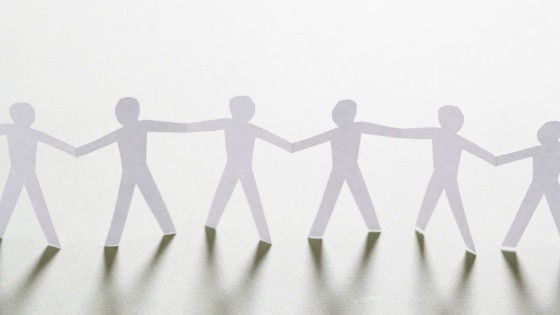
Reach out and thank a board member
The new Rainbow Community School Board has been diligently working. Over the summer they attended trainings and began the process of revising a number of board policies.
This is a monumental undertaking that involves carefully analyzing each policy, discussing what it means, its ramifications, and making any needed revisions. These meetings are rich and thought-provoking. The board is truly committed to what is most important: the students! You will be able to identify board members at various campus events. They will have a button that lets you know who they are. If you see them, please thank them for their wisdom and hard work.
As a friendly reminder, don’t forget to VOTE! Early voting goes until November 3.
The world may seem pretty wobbly and often disturbing these days. But when all of us just do the simple things within our control, it makes a difference.
There is so much hope. Everything can change in an instant! I leave you with an excerpt from a poem my husband recently shared with me. (My favorite line is in bold.)
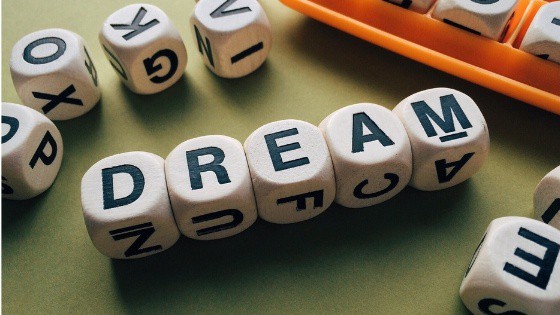
Someone is dreaming of adoring you
Someone is writing a book that you will read in the next two years that will change how you look at life.
Nuns in the Alps are in endless vigil, praying for the Holy Spirit to alight the hearts of all of God’s children.
There are Tibetan Buddhist monks in a temple in the Himalayas endlessly reciting mantras for the cessation of your suffering and for the flourishing of your happiness.
A farmer is looking at his organic crops and whispering, “nourish them.”
Someone wants to kiss you, to hold you, to make tea for you.
Someone in your orbit has something immensely valuable to give you — for free.
Something is being invented this year that will change how your generation lives, communicates, heals and passes on.
The next great song is being rehearsed.
Thousands of people are in yoga classes right now intentionally sending light out from their heart chakras and wrapping it around the earth.
Millions of children are assuming that everything is amazing and will always be that way.
Someone just this second wished for world peace, in earnest.
Someone is fighting the fight so that you don’t have to.
Some civil servant is making sure that you get your mail, and your garbage is picked up, that the trains are running on time, and that you are generally safe.
Someone is dedicating their days to protecting your civil liberties and clean drinking water.
Someone is regaining their sanity.
Someone is coming back from the dead.
Someone is genuinely forgiving the seemingly unforgivable.
Someone is curing the incurable.
Someone loves you more than you can ever know.
Me. You. Some. One. Now.
~author unknown
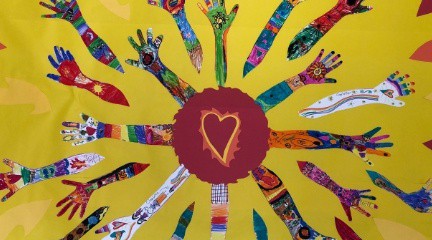
by West | Oct 23, 2018 | Blogs, Home Page News, Rainbow Institute
In 2012 Rainbow Community School (RCS) was selected as an Ashoka Changemaker School, a network of schools that empower students as changemakers by prioritizing empathy, leadership, and collaborative problem-solving as student outcomes. They recognize the capacities of young people to make a BIG difference and highlight empathy as the centerpiece for all changemaking efforts. RCS was nominated as a changemaker School because of its belief that educating for the wholechild directly impacts humanity’s collective awareness and capacity for growth.
The Journey from I to We:
Gandhi’s wise words remind us that it all begins with our inner selves: “Be the change that you wish to see in the world.” At RCS, we believe that real change originates out of an individuals’ commitment to their own evolution. As a result, we strive to support all learners in becoming whole, finding purpose and then making change. Our educational model nurtures the holistic development of the child and by doing so, these whole humans are better equipped and more empowered to serve the needs of humanity and the planet through their positive change making efforts.
It is not uncommon for our learners to acknowledge that before they can show up for others they must show up for themselves and it is the emphasis on self-discovery and personal well-being that opens the doors to connection, collaboration and thus meaningful work. Our students explore, at a very young age, what it means to “know thyself” by recognizing their unique gifts and exploring practices that highlight self-empathy and self-gratitude.
By inviting a child’s inner life into the classroom we are awakening their spirit. A spiritually nourished child is not only ready to learn but it’s the child’s strong spiritual identity that is the catalyst for meaningful work. The catalyst for change!
There are certain stand out elements of the Rainbow Seven Domains Learning Model that help to create favorable conditions for spiritual identity development and the daily centering practice is one of them. This morning ritual serves to awaken the spiritual center of each child, opening pathways to learning. As a centering begins, the classroom is filled with ritual and reverence. These rituals vary from classroom to classroom but the essence of centering is such that the students gather in a circle on a rug, the space is set with intention, the lights are dimmed, a chime or bell invites silence, reverence fills the room, a pause is taken for audible breath work, the invitation of fire through candlelight is summoned- this begins the sacred work of the day. The results are often a harmonious learning environment in which focused thinking come naturally, trust among the group yield effortless work and innovative solutions are manifested.
Recently I joined Lucy and the preschool Dragonflies for centering. The preschool centering ritual leader began by asking his class to put on their mindful bodies and their mindful listening ears. He then told them that he would ring the singing bowl and wanted every person to actively and mindfully listen until they could no longer hear the song of the bell and then to raise their hand when its song was gone. He then used a breathing ball and guided his classmates in three deep inhales and exhales. As the ball expanded he said aloud “inhale” and as it contracted he said “exhale.”
Lucy, then invited the preschoolers to join her in a self-affirming morning verse that was paired with sign language. The kids spoke the words with confidence and enthusiasm… “May I be healthy, may I be strong, may I be happy, may I be peaceful.” I was happy to witness the use of self-affirmations with such young learners. Positive affirmations or positive self-talk are great motivators for self-reflection and self-change. Statements such as these can easily become identity statements. Thus, benefiting not only oneself but those that you interact with.
Lucy deepened the experience by extending the lesson. She went on to explain that each person would have the opportunity to choose a kind wish they have for themselves. She showed and read the kind wish cards aloud and asked to kids to be thinking about which kind wish they wanted for themselves today. When the kids were ready to share, they signaled to Lucy by placing their thumbs on their knees.
She invited each them to approach the altar which was filled with the kind wish cards, candles and the wishing water. The kids were asked to speak their kind wish aloud and in the direction of the wishing water. It was obvious that Lucy had worked hard to create a supportive and safe yet vulnerable space for the Dragonflies as each child spoke, the rest of the group held a quiet space.
Finally, Lucy reminded the children that much like plants need our care to thrive, our intentions and affirmations need that attention too. As the centering practice came to a close, she explained, that she would take the wishing water (filled with their wishes) and send the kind wishes in to the world by watering the plants and that the plant’s health and growth will be a visual reminder of our own personal growth.
If we feed our body, it can grow. If we feed our mind, it can be stimulated. If we nurture our spirit, it can flourish. What daily affirmations will help you flourish?
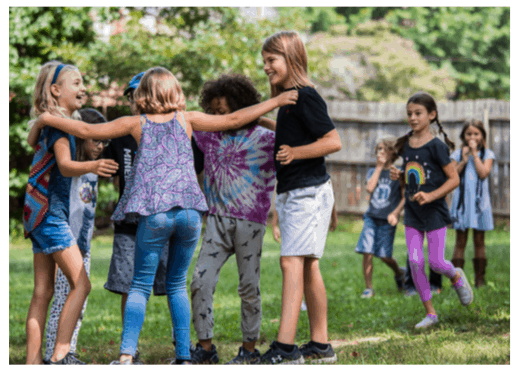
by West | Oct 23, 2018 | Blogs, Home Page News, Rainbow Institute
Connection and community at Rainbow is often nurtured through rituals, traditions or celebrations that mark the passage of time. We begin the school year with an opening ceremony during which the entire school comes together to offer blessings and intentions for the coming year. On that same day we also host a Rose Ceremony. This ceremony happens twice each year; on the first day of school and on the last day of school.
The ceremony on the 1st day of school is designed for the oldest students (8th graders) in the school to welcome the 1st graders into elementary school. Each 8th grader gives a 1st grader a rose to symbolize their support as they transition. This important rite of passage is replicated on the last day of school as the 8th graders graduate. The 1st graders offer them a rose to mark their transition.
Also during the first week of school, each class chooses a mascot. Choosing a class mascot has been a community building tradition at Rainbow for years. This tradition yields many benefits. Students are using the mental domain to formulate logical arguments about their mascot choice, the social domain to share their ideas and participate in a democratic voting process, the spiritual domain by learning about symbolism of the mascot and/or striving to embody the qualities of those animals. The mascot provides the class a shared identity and deepens group cohesion.
We also gather for a weekly song circle. This is a simple and joyful way to engage in the universal language of music while also offering a special bonding experience across the age groups.
Additionally, throughout the course of the year, we hold fire circles that help us honor the seasonal cycles and our own inner cycles. The circles foster a support system for deep reflection, invite gratitude and, nurture the well being of all community members who attend. As we gear up for the Fall equinox, a fire burns on campus, extending the invitation to sit, to breathe and to connect.
These are a few of the community connection opportunities offered in the first few weeks of school. We invite you to find ways that integrate modified rituals such as these in your home, classroom or organization.

by Renee Owen | Oct 17, 2018 | Blogs, Director's Blog, Heart of the Matter

What’s in a mission?
This school year I will be writing a series for Heart of the Matter based on our board Ends Policies. Ends Policies are written by the board as the guiding light for our school.
They point the way toward who we want to be and where we want to go. Ends Policies may seem lofty because they are meant to be grand goals that we may never fully reach but we are always working toward.
Ends Policies
The Executive Director is responsible for implementing systems and programming at Rainbow Community School that work toward our Ends. For this series of Heart of the Matter, I will be sharing my interpretation of each Board Ends Policy so we all know what our intentions are as a community.
The first and most important Ends Policy is our mission. What follows is an interpretation of our mission that is broken down, phrase by phrase. I hope that this feels as alive in you as it feels alive in me.

Reneé Owen, Executive Director
We develop:
This first verb in our mission is very important. As we often state, an education at RCS is more about development than mere achievement. Learning is the core of education. However, if learning is only instrumental, technical, or social conditioning, it is not sufficient to create humans who will become their highest selves — humans who will help society to evolve to reach its highest potential.
Stages of Development
Human development is a complex matter that, according to science, comes in stages. Children will remain at one stage for many years, but while they are in that stage, we are preparing them to successfully and beautifully transition into the next stage of development when they are developmentally ready.
Additionally, we are helping them lay a foundation for successful development throughout adulthood by teaching them how to think critically, have strong character with positive values, and be integrated “whole” human beings. Achievement comes naturally when humans have been educated to understand and utilize their whole selves.
Developmentally Appropriate
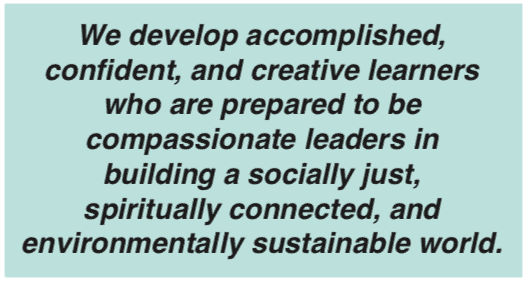
Note that the term “developmentally appropriate” is often heard at Rainbow. As pedagogical scientists, we understand the appropriate abilities of learners at various ages.
We know, for example, that you can teach a child to mimic advanced academic behavior at an age that is premature for them to truly understand it deeply, therefore stunting their ability to be more advanced at older ages. Likewise, we know that when only one aspect of development is overemphasized at stages of development, it stunts holistic development in other domains.
False Development
The most common example in our society is the advanced “false” development many schools try to force onto children before they are ready. Because the children are not ready, forcing such advanced academic work on them requires cutting out other activities that would develop their whole selves such as play, creative activities, and unstructured social time.
When one area of the brain is overemphasized, developmental “windows” of opportunity are missed in other areas. These missed developmental opportunities can never be fully recovered, and can result in a host of maladies, notably mental health issues.
Accomplished, confident, and creative:
Beauty, Truth, and Goodness
In general, this triad is meant to evoke the triad of beauty, truth, and goodness. Although accomplished, confident, and creative don’t match up one-to-one with beauty, truth, and goodness, the concept of health and wholeness coming in triads is important.
Triads create balance that a duality can never achieve. Triads create a dialectic where two aspects of a triad may be working together or in tension with one another, and then the third element is a catalyst for change or evolution/development to a higher level.
Although it is not exact, or one-to-one, as I say above, this triad of accomplished, confident, and creative loosely relates to beauty, truth, and goodness as such:
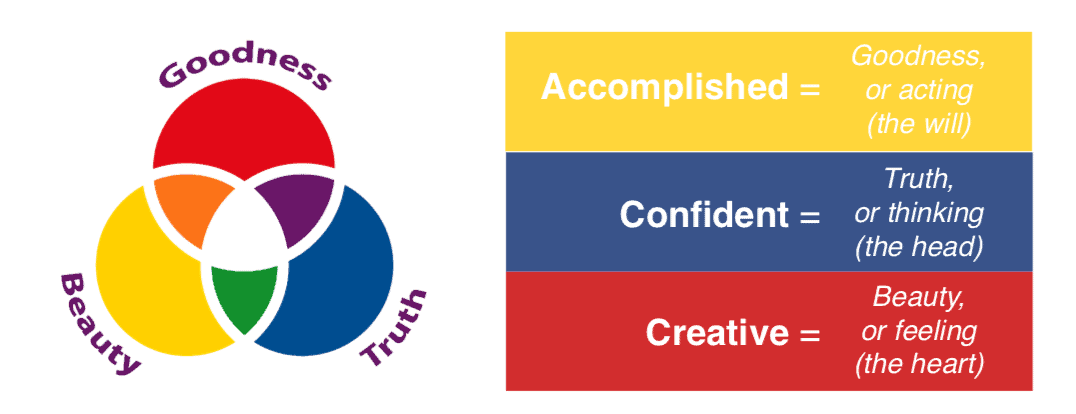
Accomplished:
RCS is not just a learning lab where students will devour knowledge provided by a teacher; it is real life. We want students to have authentic experiences in the world including opportunities to see problems in the world, and to act out of goodness to alleviate them, either through service, service- learning, or creating inventions and design plans that have the potential to help.
“Accomplished” also means that students need to be productive. They need to leave RCS having literal, material accomplishments such as awards and achievements; and they also (or more so) have to establish productive and positive work habits and manners of being, so they are set up for success for the rest of their lives.
Confident:
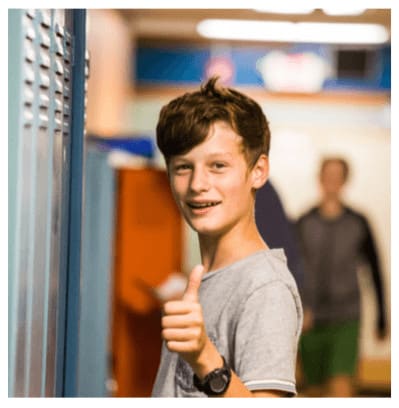 “Confident” has to do with the way learners approach the world. We want learners to see themselves confidently as forces of good in the world.
“Confident” has to do with the way learners approach the world. We want learners to see themselves confidently as forces of good in the world.
To have this sense of confidence, they need to have worked to find their own personal truth, including understanding that truth is a flowing concept and they will forever be changing and adapting their truth as they confront new realities in life and in their being.
This means they have to be robust critical thinkers who don’t merely consume information, but evaluate and apply it. This means they need to have developed an epistemological stance in life where they can understand complexity, think in systems, and later in life visualize and mentally manipulate systems within systems.
Creative:
The creative learner has developed their heart. In the triad of head, heart, and hands, they have learned that the heart – not the head – is truly the best “boss;” and when the triad is in balance, the head and the hands are in service to the heart.
Creative learners have had the immense privilege of being allowed to “follow their heart” and have discovered those results experientially. Through taking such risks they have learned wisdom through mistakes, including the wisdom to know that mistakes are necessary, forgivable, and often lead to brilliance. Partly, through their own experience with mistakes, they have developed true compassion for the human-ness of others.
Creative learners are in touch with their intuition. They are inspired by ideas that come from beyond… beyond somewhere anyone can explain. They have access to such inspiration because their conduit to creativity has not been criticized or cut off, but nurtured and encouraged. They have rich experiences of working on the right side of their brain and getting into “the zone.”
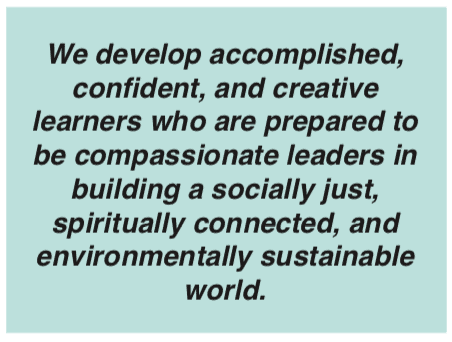
Prepared:
“Prepared” looks different for every student, for
every learner has different gifts and challenges.
Therefore, prepared means making sure each student has developed essential learning skills that have prepared them to continue learning throughout life.
Part of this preparedness means being able
to meet the world with one’s authentic self – so by the end of eighth grade students will have prepared themselves through deep personal analysis and inner reflection.
Compassionate:
In part, “compassionate” is in contrast to “competitive.” Although there is solid scientific evidence that some humans have the competition gene and need healthy opportunities to compete for proper development, the idea of having competition as the bedrock of society is, according to anthropological evidence, completely misguided.
Humans would not have survived thus far if they were not naturally collaborative – working together and pooling the greater mind of the group to overcome nature. Unfortunately, we became so good at overcoming nature that we have completely dominated it to the point that our very survival now depends on us collaborating in ways that span vast and complex systems.
Now, instead of overcoming nature, we need to overcome greed, misguided individuality, and paradigms of injustice. In short, we need to overcome our compulsion and deep-seated cultural habits to exploit the earth and one another.
 Learners who are compassionate have learned from a very early age to sit still and go inward to reflect on their emotions and notice how emotions affect their thoughts and actions (and more emotions).
Learners who are compassionate have learned from a very early age to sit still and go inward to reflect on their emotions and notice how emotions affect their thoughts and actions (and more emotions).
They have learned how to articulate these emotions, and therefore, recognize emotions in others. They have learned empathy – the ability to relate to the feelings of others and to be connected human beings. This helps learners communicate in a manner that breaks barriers and frees the mind and heart to learn and to learn even more by collaborating and working with others. Compassionate learners don’t just feel, they act out of this compassion.
Leaders:
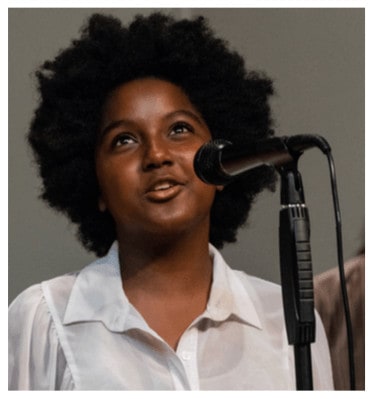 Note that compassion does not stand alone in the mission, but as a descriptor of the word “leaders.” Compassionate leaders have learned, as mentioned above, that the heart is actually the most appropriate personal “leader.”
Note that compassion does not stand alone in the mission, but as a descriptor of the word “leaders.” Compassionate leaders have learned, as mentioned above, that the heart is actually the most appropriate personal “leader.”
They are considerate of others in their decisions. After all, that is what leaders do – they consider others.
The word “leaders” – like all words in our mission – was considered carefully. In this case, the concern was whether or not the term implies forced leadership, or the expectation that every student be a dominant person, when the world has enough dominate people. In the end, it was decided that anyone who is a good role model is a leader, and good role models are what we expect a Rainbow graduate to be.
Building:
Whether we are still designing, excavating, or have moved onto laying the foundation or even construction, the point is that Rainbow graduates will be helping the world make positive progress toward becoming a socially just, spiritually connected, and environmentally sustainable world.
They will not take, they will give. They will not rest (except to the degree resting is healthy), they will work. They will not give up because it’s hard, or it’s painfully slow, or because sometimes it seems like we are moving backwards. They will not give up because they cannot do it all by themselves. They will wake each morning with a purpose in life.
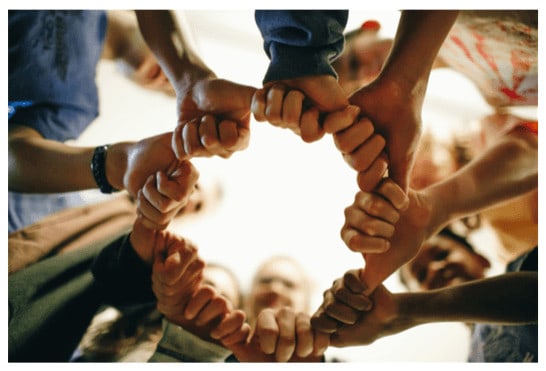
Socially Just:
This phrase is expounded upon in the interpretation of Ends-4. Here it is enough to say that the world a Rainbow graduate is working toward is one where every human has the opportunity to have not only their basic needs met, but also to become a self-actualized person, to use Maslow’s language.
Every person, no matter what their circumstances or how rare (or common) their perceived differences may be, deserves to be included and cared for by a loving, communal, societal force.
Spiritually Connected:
The interpretation for Ends-5 provides an exploration of Rainbow’s spiritual end. We envision a world where human spirituality is recognized as a core aspect of being human, if not the very thing that makes us human – that breathes life into our souls.
In such a world, spiritual development would be understood as an important aspect of education, work life, and family life. It would not be relegated to those who choose to be a part of an organized religion, but instead it would flow through the veins of our civil life.
Rainbow graduates will help create a world where we recognize, honor, enrich, and utilize our spirituality to create greater well-being for all people.
Environmentally Sustainable:
This is expounded upon in the Ends-6 report. Fritz Capra defines a sustainable society as one that “satisfies its needs without diminishing the prospects of future generations” (From the Web of Life, page 4.)
To accomplish this means shifting out of the paradigm that became firmly established during the industrial revolution of linear thinking to one that thinks and operates in systems, cycles, and webbed networks.
This also means shifting out of the current American paradigm where the economic sphere is the most important, or dominating, social sphere — where virtually everything is “commoditized” and economic growth (typically for the few) and competition is the underlying mandate from whence most political and social (and individual) decisions and actions are made.
The new, sustainable paradigm would move us out of our current anthropocentric attitude (where humans are viewed as the center of the world), and put humans in relation to all of nature and as stewards of the natural world. Harmony.

Bringing it to Life
In general, as practitioners of holistic education, we know that the whole is always much greater than the parts added together. For the sake of analysis and greater understanding I have broken our mission statement into parts and pieces, but our mission comes to life when it is whole.
Our mission comes to life every day when we live it — every morning when our teachers arise in thought and meditation for their students; every moment a child expresses wonderment and is embraced in love; every year when we, as a community, come together with awe and appreciation for our human qualities – including (and perhaps especially) our faults; in order to lift one another up so that our children can be better than us.
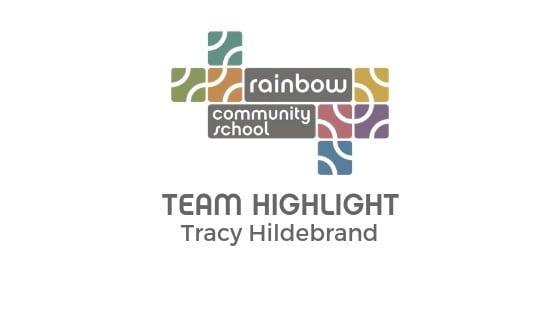
by Cynthia Calhoun | Oct 9, 2018 | Blogs, Home Page News
This month’s team highlight: Tracy Hildebrand
We’d like to introduce you to Tracy, Rainbow Community School’s art teacher. We found her in the art room and asked if she’d agree to answer questions for a team highlight. She has some fun answers to our questions. We hope you’ll enjoy!

You’ve taught in Virginia before. Are you originally from there?
I was born in Norfolk, Va , attended college there and taught art in Norfolk Public Schools for 7 years.
I took a break from teaching in 1992 and moved to Western North Carolina to work at Nantahala Outdoor Center where I worked teaching kayaking, guiding river rafting trips and working in the outfitters store.
I realized soon after moving here that this area is my true spiritual home.
How did you find Rainbow?
When my husband and I were looking for a kindergarten for our daughter, a friend recommended we visit Rainbow. We knew right away it was the right fit for her. Emily attended RCS from K through Omega and is now a sophomore in high school.
What do you like to do when you’re not at Rainbow?
Mostly I love to spend time with my family hiking, paddling rivers, and camping. I also enjoy gardening, cooking, yoga, and taking walks with our dog, Teeka.
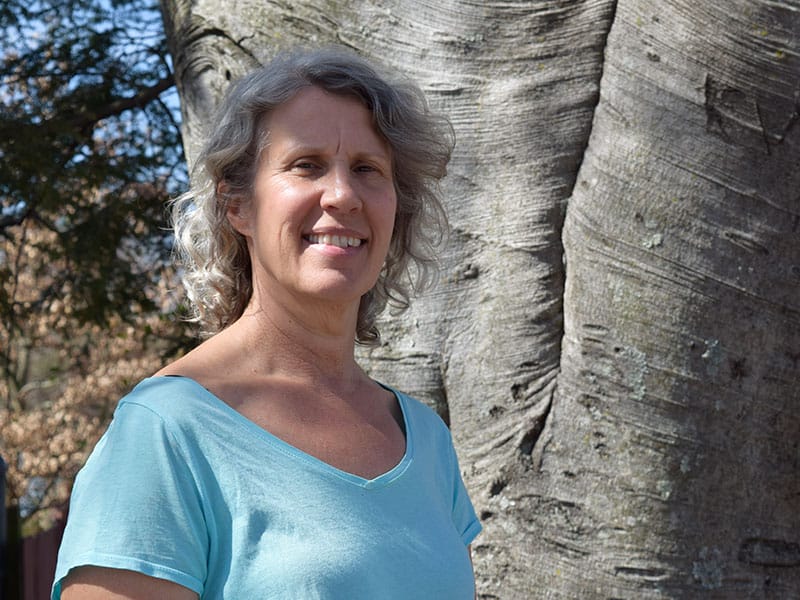 In addition to teaching art, it looks like you make jewelry. What sorts of art do you like to create?
In addition to teaching art, it looks like you make jewelry. What sorts of art do you like to create?
I don’t make jewelry anymore, actually.
What’s the best way to start the day?
Sitting on our front porch sipping coffee, reading a good book, and watching the birds visit our bird feeder. I love observing them and seeing how they interact with each other.
What book(s) are you reading?
Braiding Sweetgrass by Robin Wall Kimmerer, and I highly recommend it!
What’s the farthest you’ve traveled from home?
I traveled to Rio de Janeiro with my Mom. She was born and raised there until she was 20. I was able to see where she lived as a girl.
If you could talk to any person, living or deceased, for half an hour, who would it be?
I would love to spend time with Georgia O’Keefe. I admire her strength as a woman and that at one point decided to lay aside what she had been taught in art school and developed her own technique and style. In addition, she lived a very unconventional life for a woman in her time. I admire that she lived her life on her own terms.
What is something your friends would consider “so you”?
My husband and daughter consider anything to do with flowers a ‘Tracy thing’. I especially love wildflowers – to find them along a woodland trail brings me great delight. I grow native wildflowers in our yard.
One of my dearest friends shared all kinds of native flowers from her yard with me years ago; mayapples, ferns, soloman seal, columbine, and many more.
One of my favorite quotes is “Earth laughs in flowers” by Ralph Waldo Emerson.
We hope you enjoyed Tracy’s team highlight. Don’t forget to tell her that “Earth laughs in flowers” when you see her!
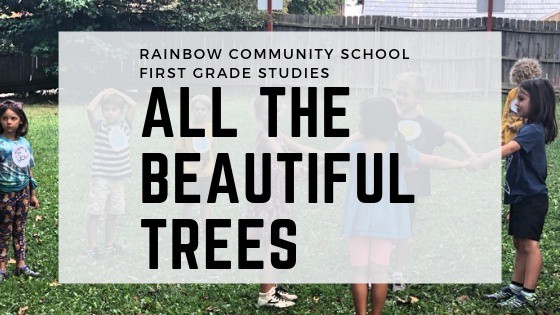
by Cynthia Calhoun | Sep 12, 2018 | Blogs, Home Page News
First Grade Studies Beautiful Trees
We stepped into first grade recently, into a veritable classroom forest. There were displays of books about trees, nature artifacts that reminded us of our natural roots, and artwork that featured patched trees and their individual parts. First grade is studying beautiful trees in all their splendor.
The first grade “wolves,” as they call themselves, were contentedly reading to each other. They quietly tried out new words and soaked up fun ideas from illustrated books.

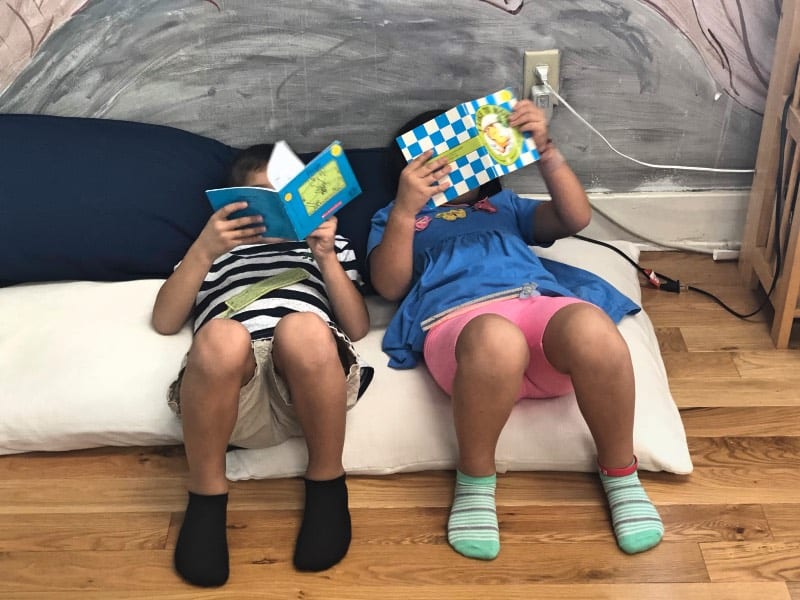
The Story of Trees
Their teacher, Rachel, guided them into a circle where they recited a poem about trees. They swayed like leaves, or dropped to the floor like apples. They sang and recited verses from the song, “I’m a Tall, Tall Tree.” At the conclusion, students huddled together to hear a story.
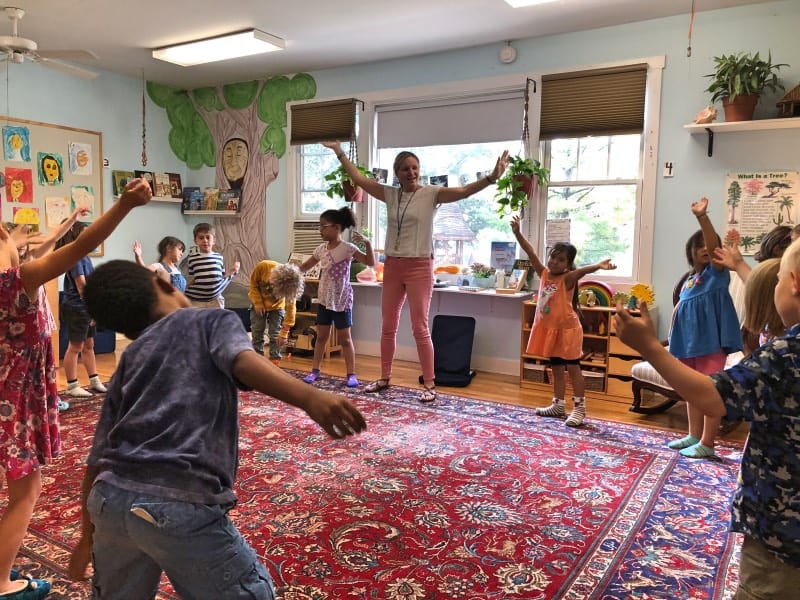
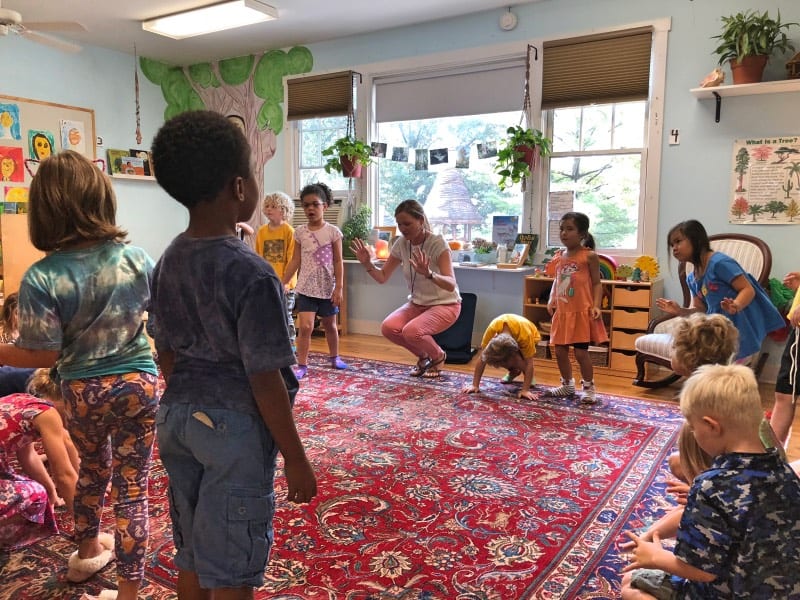
Ms. Rachel read about many different trees that grow. She asked her students about all the different varieties they might have already known: “Apple tree!” one said. “Maple! Peach! Magnolia!” chimed others. First graders are about the same age as it takes for an apple tree to mature: 6-10 years, depending on the species.
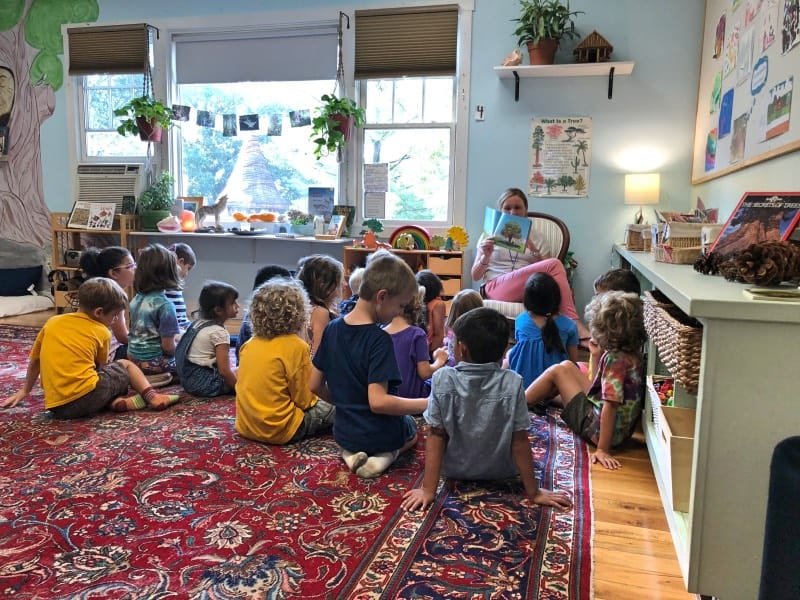
The Four Elements to Make a Tree Grow
They arrived to a part in the book that detailed the four elements of what trees need to grow big and strong.
These first graders already knew:
Air. Water. Soil. Sunlight.
A Little Space
But there was just one more thing that trees needed to grow. What was it?
Rachel called up one student. Then another and another until there were four, standing so close together they could hardly breathe….
All these students were “trees that hadn’t fully grown” and they quickly figured out what that last thing was. Trees need space.
These four students spread out and demonstrated how having a little space made it much easier to spread and grow.
So many life lessons in that statement: having a little space makes it much easier to spread and grow.
The Natural and Physical Domains
There was more. Each student became an “element.” Rachel handed out cards of either air, soil, water, or the sun. Students wore them as badges of honor as they imagined they were air, water, soil, or sunlight. They lined up to head toward the outdoor classroom to incorporate two different modalities of learning: the natural and physical domains.
Rachel’s instructions were to run around the outdoor classroom, but when they heard, “1-2-3-GROW!” each person had to find the other elements that would make a tree. When all four students – elements – were joined, they’d make a circle, giving themselves some space. As they successfully “grew into a tree,” they’d exclaim, “I’m a tree! I’m a tree! I’m a tree!”
After several rounds of finding the different elements, students returned to their classroom. This space is a peaceful oasis that peers out to the Gnome Village below, giving the impression that they are, in fact, in a tree house. We knew they were secure in the knowledge that they wouldn’t soon forget what makes a tree grow from a seedling into a sprawling giant.
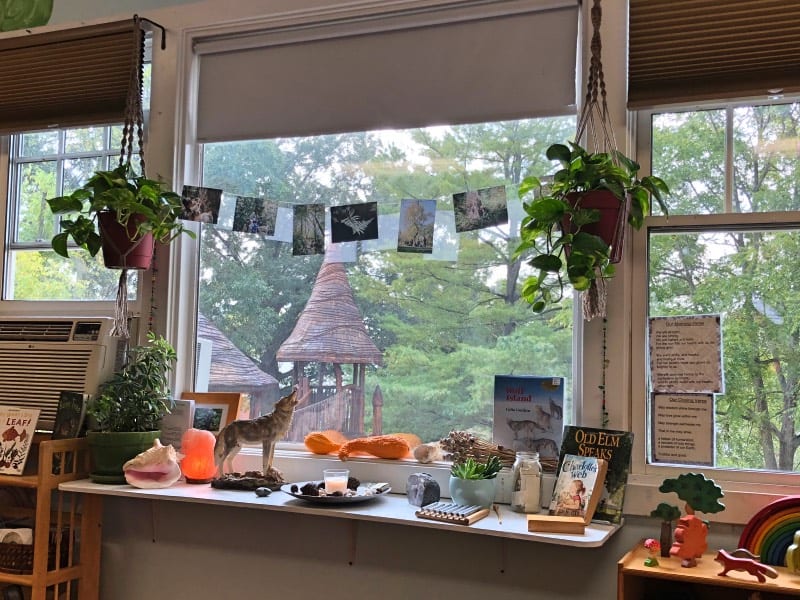

















 “Confident” has to do with the way learners approach the world. We want learners to see themselves confidently as forces of good in the world.
“Confident” has to do with the way learners approach the world. We want learners to see themselves confidently as forces of good in the world.
 Note that compassion does not stand alone in the mission, but as a descriptor of the word “leaders.” Compassionate leaders have learned, as mentioned above, that the heart is actually the most appropriate personal “leader.”
Note that compassion does not stand alone in the mission, but as a descriptor of the word “leaders.” Compassionate leaders have learned, as mentioned above, that the heart is actually the most appropriate personal “leader.”


















